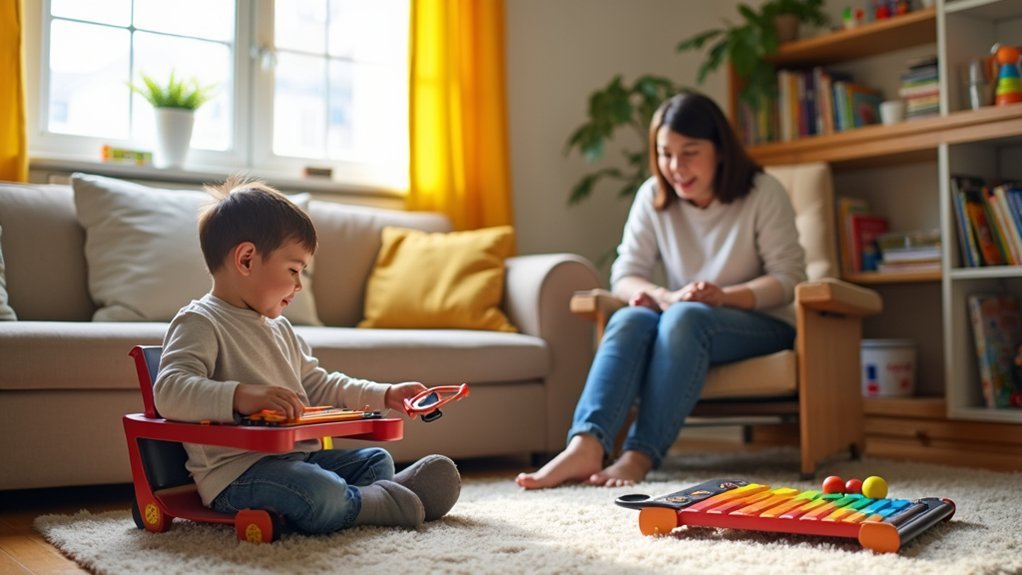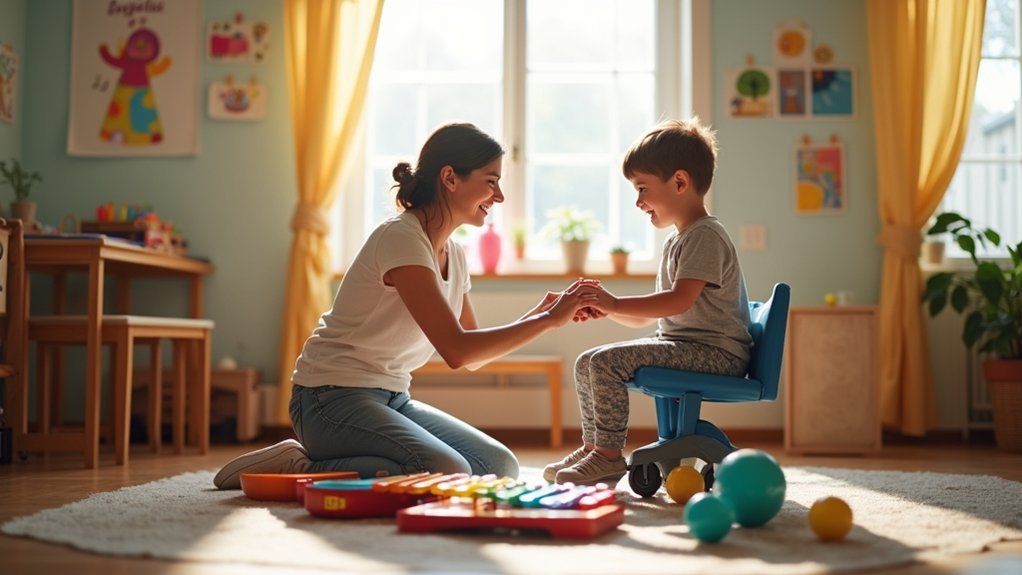Music therapy for cerebral palsy uses adaptive instruments that match your child’s mobility levels—from touch-sensitive keyboards to theremins requiring no physical contact. Implement rhythmic auditory stimulation (125-140 bpm) to improve motor control and coordination. Set up an accessible music space at home with appropriate instruments and consistent practice schedules. Choose a certified therapist with CP experience, and track progress through standardized evaluations. The right musical approach can reveal movement capabilities traditional therapies might miss.
Adaptive Instruments for Different Mobility Levels in Cerebral Palsy

While cerebral palsy presents unique physical challenges, adaptive instruments have revolutionized music therapy by making musical expression accessible to everyone.
You’ll find electronic keyboards with touch-sensitive keys that respond to even minimal movement, allowing children with various mobility levels to create melodies and develop skills.
Consider Theremins for those with severe limitations—they require no physical contact, just hand movements in the air.
Modified guitars with lighter strings help children experience success despite limited dexterity, while adaptive drum kits with larger pads support those with reduced arm strength during rhythmic activities.
Technology-assisted instruments have expanded participation options further.
App-controlled devices responding to motion or breath offer innovative ways for children with cerebral palsy to engage in music-making, aligning with therapeutic goals regardless of their physical capabilities.
Rhythmic Auditory Stimulation Techniques for Improved Motor Control
The powerful connection between rhythm and movement forms the foundation of Rhythmic Auditory Stimulation (RAS), a specialized approach that can transform motor control in children with cerebral palsy.
When you implement RAS in music therapy sessions, you’ll use consistent rhythmic patterns—ideally between 125-140 beats per minute—to help your child synchronize their movements. This technique works by engaging multiple sensory modalities, particularly the auditory systems, to reinforce new motor skills.
You’ll notice improvements in your child’s gait performance as they learn to match their steps to musical rhythms. Research shows RAS greatly enhances stride length and overall coordination.
Setting Up an Accessible Home Music Environment

Building on the principles of Rhythmic Auditory Stimulation, creating an accessible music environment at home allows your child to practice and benefit from music therapy consistently.
Designate a space that encourages children with cerebral palsy to engage with music through exploration and play.
- Select accessible instruments like keyboards, xylophones, and drums, along with adaptive tools that accommodate your child’s specific physical limitations.
- Incorporate technology such as tablets or music apps that enable interactive music-making, especially beneficial for children with limited mobility.
- Maintain a steady rhythmic auditory stimulation during sessions to help synchronize movements and develop motor skills.
- Establish a consistent schedule for routine practice, which promotes neuroplasticity through repeated engagement with musical activities.
Choosing the Right Music Therapist for Your Needs
Finding the right music therapist represents one of the most essential decisions you’ll make in your child’s therapy journey. Always verify certification through the American Music Therapy Association (AMTA) to guarantee proper training for working with children who have cerebral palsy.
| Evaluation Criteria | What to Look For |
|---|---|
| Experience | Specialization with cerebral palsy cases |
| Approach | Individualized music therapy plans tailored to specific needs |
| Activities | Range of options including instrument play that matches your child’s interests |
When interviewing potential therapists, assess their communication style with both you and your child. A strong therapeutic relationship often leads to better outcomes, so don’t underestimate the importance of personal connection. Ask detailed questions about how they’ll address your child’s unique needs through their music therapy sessions.
Measuring Progress and Celebrating Musical Achievements

Since music therapy produces diverse benefits that aren’t always immediately visible, establishing clear metrics to track your child’s progress becomes essential for recognizing growth and maintaining motivation.
By monitoring therapy goals related to motor skills and emotional regulation, you’ll notice meaningful improvements that validate your commitment.
Tracking progress in therapy reveals the subtle yet profound changes that make your investment worthwhile.
- Use standardized evaluations like the Pediatric Quality of Life Inventory to objectively measure well-being and sleep quality improvements.
- Document small milestones such as better rhythm timing or new instrument skills to boost your child’s confidence.
- Share achievements with family members to create a supportive environment that enhances social development.
- Celebrate performances and musical accomplishments to reinforce your child’s engagement and motivation in therapy sessions.
Frequently Asked Questions
How Does Music Therapy Help Cerebral Palsy?
Music therapy helps cerebral palsy by activating your brain’s neuroplasticity. It improves your motor function, sleep quality, and emotional control while you’re engaging with rhythmic activities that enhance coordination and spatial awareness.
What Are the 4 Methods of Music Therapy?
The four main methods of music therapy you’ll encounter are Rhythmic Auditory Stimulation (RAS), Therapeutic Instrumental Music Performance (TIMP), Patterned Sensory Enhancement (PSE), and Oral Motor and Respiratory Exercises (OMREX).
What Is the Most Common Therapy Strategy to Help Cerebral Palsy?
Music therapy is the most common strategy for helping cerebral palsy. You’ll benefit from techniques like Rhythmic Auditory Stimulation, which improve your motor function by synchronizing movements with rhythm during rehabilitation exercises.
What Are the 5 Elements of Music Therapy?
The 5 elements of music therapy are therapeutic relationship, active participation, rhythmic auditory stimulation, multisensory engagement, and individualized approach. You’ll benefit from each element as they work together to enhance your treatment outcomes.
In Summary
Music therapy offers a powerful avenue for anyone with cerebral palsy to improve mobility, coordination, and emotional well-being. You’ll find that with adaptive instruments, specialized rhythmic techniques, and the right therapist, you’re revealing new potential. Don’t forget to create an accessible music space at home to continue your practice. As you measure your progress, remember that each musical achievement, no matter how small, is worth celebrating.





Leave a Reply